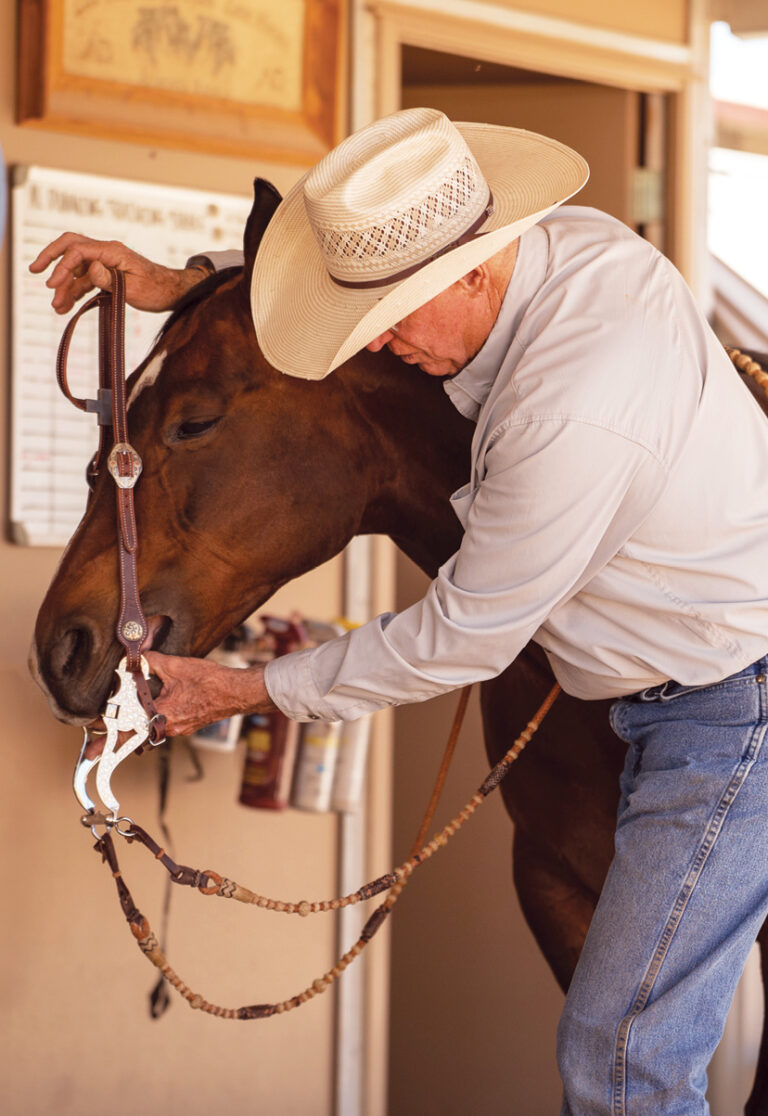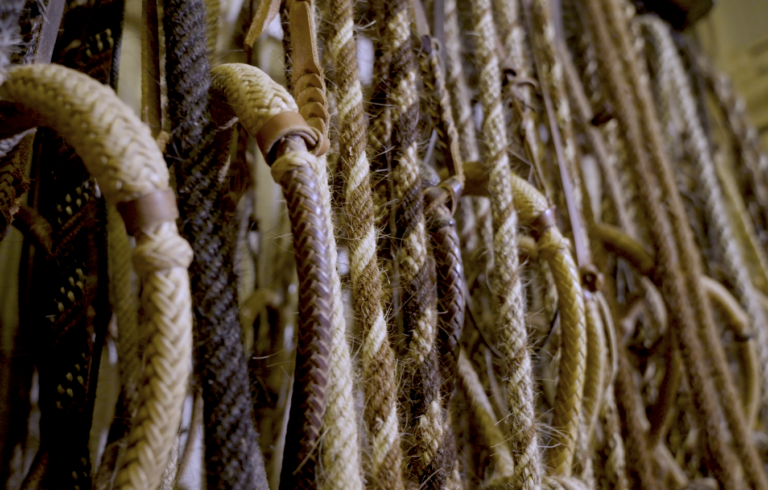Q: Recently, while trail riding, a friend’s horse stuck his tongue out to the side as soon as she asked him to canter. Another friend said, “Oh look, her horse is licking and chewing. That means he’s thinking.” However, the horse didn’t look relaxed, and it wasn’t an “aha” moment. What do you think of this behavior? Should a horse’s tongue ever be out while under saddle?
Nancy Jackson
A: It sounds as though there’s a bit of confusion here. Licking and chewing is definitely a different behavior than a horse sticking his tongue out while you’re riding.
Licking and chewing can be seen when a horse is relaxing; in training, this behavior often occurs when the horse understands and is compliant.
There’s a lot of discussion about the behavior and what it means, but it’s a good sign. I watch for the behavior and study it quite a bit. I love knowing how the brain and body work together — especially under stress.
When a horse is licking and chewing, his lips and jaw are working softly. He’s swallowing with his tongue, but he doesn’t stick his tongue out. He may occasionally lick his lips a little bit, but it’s very different than sticking his tongue far outside his mouth.
A Moist Mouth
Here’s a little more background on how licking and chewing works.
Just like humans, horses salivate constantly. Just like humans, horses don’t drool; they swallow their spit.
Horses produce enough saliva to fill a bucket every day. That salivation is important to their physiology — they need the saliva to keep their mouths moist to dampen feed and move it through the digestive tract.
When your horse becomes tense and anxious, his salivation stops. Just as when you’re nervous and get cottonmouth (think of when you had to give a speech in school), your horse stops salivating when he’s anxious. When he relaxes once again, the saliva process starts again, and that’s the moment that he licks and chews.
When you’re training your horse to do something new, he stops salivating when he’s thinking, What are you asking? What do you want me to do? When he figures it out, he starts salivating again, and licks and chews to help lubricate his mouth.
Learn More: Bits That Go Ouch
This behavior has been condensed and commonly shared as, “When a horse is licking and chewing, that means he’s thinking.” That’s almost true, but it isn’t the whole story.
The licking and chewing actually means that the horse has moved back to relaxation from a state of anxiety.
Endorphin Release
A horse that sticks his tongue outside his mouth presents a complicated behavior that can be difficult to resolve.
First, find out if the horse sticks out his tongue all the time or only while being saddled and bridled. That information will help you know whether he has developed an endorphin-seeking behavior exhibited all the time or if he’s uncomfortable only in his tack.
Endorphins (endogenous morphine) are opioid peptins—neurotransmitters produced by the pituitary gland and the hypothalamus that produce a feeling of well-being and can act as a painkiller.
A horse gets an endorphin release when he sticks out his tongue and bites it. If you see a horse sticking out his tongue and chewing on it when he’s just standing in his stall, he has learned this behavior and has almost become addicted to the feeling.
Saddle fit or back pain may also cause the horse to seek a way to find an endorphin release. This comes to mind especially because you say this only happens at the canter. Moving into that gait might create mouth pain (see below) or pain elsewhere in his body.
Advise the horse’s owner to have a veterinarian rule out any physical pain.
Bit Problems
If your friend’s horse sticks out his tongue only when bridled, it’s most likely because the bit is bothering his mouth.
There are many ways a horse attempts to avoid a bit that’s causing too much tongue pressure. He could be stargazing (holding his head high), coming behind the bit, opening his mouth, or sticking out his tongue. All these behaviors are engaged to relieve tongue pressure.
If I know the horse is sticking out his tongue only when bridled, I immediately think about switching to a bit that offers tongue relief.
Here’s the caveat, though: Many of the bits riders think are the most comfortable actually increase tongue pressure. For instance, a fat bit, while dispersing pressure over a wide surface, actually places more pressure on the tongue, because there’s not enough room for that much bit in the mouth.
If you use a three-piece mouthpiece thinking that’s more comfortable, note that some are actually designed to place more pressure on the tongue.
Even with a snaffle (a direct-pressure bit without shanks), the mouthpiece can collapse around a horse’s tongue and apply pressure that the horse learns to avoid.
There’s no one magic answer or one bit that’s best. I’d start experimenting with bits designed to relieve tongue pressure.
I make sure the bits I use don’t collapse in the middle, but rather are made to curve around the horse’s mouth.
A bit that’s single-jointed and only folds in the middle will clamp down and place pressure on the tongue. A bit that collapses in the middle and has shanks creates the most pressure of all.
The Rider
The horse might not like the bit or the pressure on the bit. And when the rider collects the reins to canter, she may be applying too much contact on the horse’s mouth.
When a horse picks up the canter, he moves his head down into the bit on the first stride and every stride thereafter; if the rider doesn’t release contact and ride with elastic arms, the horse hits himself in the mouth on every stride.
This horse may’ve learned to avoid that pressure by sticking out his tongue when he’s asked for a canter.
Many riders don’t realize how much pressure they’re holding on the horse’s mouth — especially when they move to the canter.
Time Will Tell
The solution here may lie in a combination of finding a comfortable bit and/or saddle and teaching the rider to relax her hands. However, it may still take time to change the horse’s behavior.
Once a horse has adopted a coping behavior, it takes time to train him to stop that behavior, or replace that behavior with a more desirable one.
Some horses gradually diminish the behavior over time when they realize that the pain they felt before is no longer an issue. Others become “addicted” to the feeling of the endorphin release and continue the behavior even after they’re in a new bit.
Some horses will stop sticking out their tongue in a few days. Others may take a few weeks to totally eliminate the behavior. For many, there will be an immediate and dramatic resolution when the right bit is found.
Julie Goodnight (www.juliegoodnight.com) lives in central Colorado, home to miles of scenic trails. She trains horses and coaches horse owners to be ready for any event, on the trail or in the performance arena. She shares her easy-to-understand lessons on her weekly RFD-TV show, Horse Master, and through appearances at clinics and horse expos held throughout the United States. She’s also the international spokesperson for the Certified Horsemanship Association (www.cha-ahse.org).
Heidi Melocco (www.wholepicture.org) is a lifelong horsewoman, equine journalist, and photographer based in Mead, Colorado.




